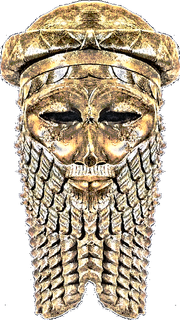
Babylonia consists of the northern region of Akkad (Accad); and the southern part being Sumer (or Chaldea). In Bible history this territory was designated as “the land of Shinar” (Ge 10:10; 11:2) or “land of the Chaldeans” (Jer 24:5; 25:12; Eze 12:13). Some of the ancient cities in Babylonia were Adab, Akkad, Babylon, Borsippa, Erech, Kish, Lagash, Nippur, and Ur. The Babylonian Empire, of course, extended beyond Babylonia, taking in Syria and Palestine down to the border of Egypt.
Old Babylon[]
About the first half of the eighth century BCE, an Assyrian king by the name of Tiglath-pileser III (Pul) ruled Babylonia. Later a Chaldean called Merodach-baladan became the king of Babylon, but after 12 years he was ousted by Sargon II. Sennacherib, in succeeding Sargon II, faced another Babylonian revolt led by Merodach-baladan. After Sennacherib’s unsuccessful attempt to capture Jerusalem in 732 BCE, Merodach-baladan sent envoys to Hezekiah of Judah possibly to seek support against Assyria. Later Sennacherib drove out Merodach-baladan and crowned himself ruler of Babylon, a position he held until death. His son Esar-haddon rebuilt Babylon.
Neo-Babylon[]
The Neo-Babylonian dynasty began with Nabopolassar and ended with Belshazzar. In 632 BCE Assyria was subdued by this new Chaldean dynasty, with the assistance of Median and Scythian allies. In 625 BCE, Nabopolassar’s eldest son, Nebuchadnezzar II, defeated Pharaoh Necho of Egypt at the battle of Carchemish, and in the same year he assumed the helm of government. In 620 BCE Nebuchadnezzar compelled Jehoiakim to pay tribute, but after about three years Jehoiakim revolted. In 618 BCE, or during Jehoiakim’s third year as tributary ruler, Nebuchadnezzar came against Jerusalem. However, before he could be taken by the Babylonians, Jehoiakim died. Jehoiachin, having succeeded his father, quickly surrendered and was taken captive along with other nobility to Babylon in 617 BCE Zedekiah was next appointed to the throne of Judah, but he too rebelled; and in 609 BCE the Babylonians again laid siege to Jerusalem and finally breached its walls in 607 BCE
One cuneiform tablet has been found referring to a campaign against Egypt in Nebuchadnezzar’s 37th year (588 BCE). This may be the occasion when Egypt was brought under Babylonian control, as foretold by the prophet Ezekiel evidently in the year 591 BCE (Eze 29:17-19). Finally, after a 43-year reign, which included both conquest of many nations and a grand building program in Babylonia itself, Nebuchadnezzar II died in October of 582 BCE and was succeeded by Awil-Marduk (Evil-merodach). This new ruler showed kindness to captive King Jehoiachin. (2Ki 25:27-30) Little is known about the reigns of Neriglissar, evidently the successor of Evil-merodach, and of Labashi-Marduk. Some evidence indicates that Nabonidus and his son Belshazzar, were evidently ruling as coregents at the time of Babylon’s fall.
Persian Babylon[]
The Medes and Persians under the command of Cyrus the Great were on the march to take over control of Babylonia, becoming the fourth world power. During the night of October 5, 539 BCE (Gregorian calendar), Babylon was seized. According to various accounts, Belshazzar was slain. In the first year of Cyrus, following the conquest of Babylon, he issued his famous decree permitting a group that included 42,360 males, besides many slaves and professional singers, to return to Jerusalem. Some 200 years later, Persian domination of Babylonia came to an end when Alexander the Great captured Babylon in 331 BCE. By the middle of the second century B.C.E. the Parthians, under their king Mithradates I, were in control of Babylonia.
Biblical notes[]
Jewish communities had been flourishing in Babylonia. It is said that Peter the apostle went to Babylon, where he wrote at least one of his inspired letters (Ga 2:7-9; 1Pe 5:13). Jewish leaders in these Eastern communities also developed the Babylonian Targum, otherwise known as the Targum of Onkelos, and produced a number of manuscripts of the Hebrew Scriptures. The Petersburg Codex of the Latter Prophets, dated 916 CE, is noteworthy because it embodies a mixture of both Eastern (Babylonian) and Western (Tiberian) readings.
